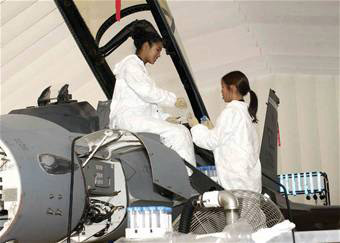 While in Washington the Joint Strike Fighter appears to be on the Quadrennial Defense Review cutting-room floor, members of the JSF integrated test force at Edwards AFB, Calif., are working hard to develop a means for the F-35 to withstand deadly chemical and biological assaults it may encounter in a future war. Testers are using a retired F-16 as a JSF stand-in during a series of three biological trials—involving a harmless spore with similarities to anthrax injected into the engine to contaminate environmental controls—and four simulated chemical agent trials. The JSF is the first fighter to have a requirement to survive chem-bio attack.
While in Washington the Joint Strike Fighter appears to be on the Quadrennial Defense Review cutting-room floor, members of the JSF integrated test force at Edwards AFB, Calif., are working hard to develop a means for the F-35 to withstand deadly chemical and biological assaults it may encounter in a future war. Testers are using a retired F-16 as a JSF stand-in during a series of three biological trials—involving a harmless spore with similarities to anthrax injected into the engine to contaminate environmental controls—and four simulated chemical agent trials. The JSF is the first fighter to have a requirement to survive chem-bio attack.
The Space Development Agency says it’s on track to issue its next batch of missile warning and tracking satellite contracts this month after those awards were delayed by the Pentagon’s decision to divert funds from the agency to pay troops during this fall’s prolonged government shutdown.

